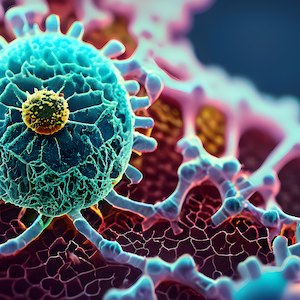Factors predicting mortality among patients with COVID-19 associated hospital acquired pneumonia: insights from a tertiary care center

Submitted: September 23, 2022
Accepted: November 18, 2022
Published: December 14, 2022
Accepted: November 18, 2022
Abstract Views: 2267
PDF: 284
Publisher's note
All claims expressed in this article are solely those of the authors and do not necessarily represent those of their affiliated organizations, or those of the publisher, the editors and the reviewers. Any product that may be evaluated in this article or claim that may be made by its manufacturer is not guaranteed or endorsed by the publisher.
All claims expressed in this article are solely those of the authors and do not necessarily represent those of their affiliated organizations, or those of the publisher, the editors and the reviewers. Any product that may be evaluated in this article or claim that may be made by its manufacturer is not guaranteed or endorsed by the publisher.
Similar Articles
- Madalina Macrea, Richard ZuWallack, Linda Nici, There’s no place like home: Integrating pulmonary rehabilitation into the home setting , Monaldi Archives for Chest Disease: Vol. 87 No. 2 (2017)
- Antonino Capizzi, Oliviero Sacco, Giovanni A. Rossi, Michela Silvestri, Recurrence of right lower lobe pneumonia 3 years after the first episode in an otherwise healthy 13-year-old girl , Monaldi Archives for Chest Disease: Vol. 87 No. 1 (2017)
- Giovanni Pulignano, Maria Denitza Tinti, Donatella Del Sindaco, Stefano Tolone, Giovanni Minardi, Antonio Lax, Massimo Uguccioni, Barriers to cardiac rehabilitation access of older heart failure patients and strategies for better implementation , Monaldi Archives for Chest Disease: Vol. 84 No. 1-2 (2015): Cardiac series
- Donatella Del Sindaco, Maria Denitza Tinti, Giovanni Pulignano, Stefano Tolone, Giovanni Minardi, Massimo Uguccioni, Antonio Lax, Cardiac rehabilitation is safe and effective also in the elderly, but don't forget about drugs! , Monaldi Archives for Chest Disease: Vol. 84 No. 1-2 (2015): Cardiac series
- A. Kaparianos, F. Sampsonas, D. Lykouras, G. Efremidis, P. Drakatos, K. Karkoulias, C. Gogos, K. Spiropoulos, Association of ET-1 gene polymorphisms with COPD phenotypes in a Caucasian population , Monaldi Archives for Chest Disease: Vol. 75 No. 2 (2011): Pulmonary series
- A. Voulgaridis, V. Apollonatou, D. Lykouras, A. Giannopoulos, M. Iliopoulou, K. Karkoulias, P. Kraniotis, C. Prokakis, M. Gkermpesi, K. Spiropoulos, Pleural Mesothelioma in a young male patient , Monaldi Archives for Chest Disease: Vol. 79 No. 2 (2013): Pulmonary series
- Domenico Galzerano, Claudio Pragliola, Mohamed Al Admawi, Mario Mallardo, Sara Di Michele, Carlo Gaudio, The role of 3D echocardiographic imaging in the differential diagnosis of an atypical left atrial myxoma , Monaldi Archives for Chest Disease: Vol. 88 No. 3 (2018)
- F. Salajka, V. BartoÅ¡, J. Novosad, J. Å t'ásek, J. Bis, M. Brtko, P. Polanský, V. KoblÞek, V. Sedlák, Failure of noninvasive prediction of pulmonary hypertension in patients with idiopathic pulmonary fibrosis , Monaldi Archives for Chest Disease: Vol. 75 No. 3 (2011): Pulmonary series
- C. Incorvaia, C. Pravettoni, M. Mauro, M.-R. Yacoub, F. Tarantini, G.G. Riario-Sforza, Effectiveness of omalizumab in a patient with severe asthma and atopic dermatitis , Monaldi Archives for Chest Disease: Vol. 69 No. 2 (2008): Pulmonary series
- I. Blanco, H. Canto, J. Flóres, C. Camblor, V. Cárcaba, F.J. de Serres, S. Janciauskiene, E.F. Bustillo, Long-term augmentation therapy with Alpha-1 Antitrypsin in an MZ-AAT severe persistent asthma , Monaldi Archives for Chest Disease: Vol. 69 No. 4 (2008): Pulmonary series
<< < 1 2 3 4 5 6 7 8 9 10 > >>
You may also start an advanced similarity search for this article.

 https://doi.org/10.4081/monaldi.2022.2436
https://doi.org/10.4081/monaldi.2022.2436





